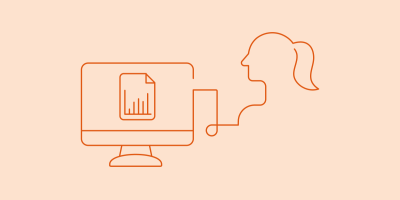Understanding the Difference Between a CDP and DMP

Consumers have millions of options at their fingertips, and modern web users don’t settle for something that doesn’t capture their attention. Think about how you’ve visited a website, been unengaged, and then navigated elsewhere. How often do you think your own site visitors have done the same?
Standing out in the World Wide Web means harnessing the data we collect, but that can be rough going when your data lacks direction, intent, and organization.
Data-driven insights, data management, and data-informed marketing strategies are popular buzzwords, but improving customer experience is the primary force behind each one. Because modern consumers have so many options, innumerable organizations battle over who’ll create the most meaningful, engaging experiences and how data will be used to create them.
In the era of customer experience, access to and ownership of customer data is crucial for brands that want to build audience relationships and measure the impact of their efforts. Technologies like customer data platforms (CDP) and data management platforms (DMP) can help organizations derive meaning from collected data and strategize accordingly.
Let’s look at key differences between a DMP and a CDP and paint a broader picture of their respective uses.
Comparing a CDP and a DMP
Despite each platform collecting and applying data to marketing initiatives, they aren’t interchangeable and deserve individual analysis. CDPs and DMPs each serve distinct functions regarding data focus and functionality. But, first, some definitions:
- Customer data platform (CDP): Collects and unifies data across channels and systems to create a single source of truth for all customer data. It pulls zero-, first-, and third-party data together to build comprehensive customer profiles and update them in real time.
- Data management platform (DMP): Collects third-party data sources — cookie IDs, IP addresses visited, and other anonymous data points — for segmentation to more effectively target those customer segments with paid advertising campaigns across diverse platforms.
The differences might not seem like much, but, depending on your organization’s intent and needs, both platforms offer unique aspects of data management. Zooming in a bit more will help identify the more nuanced differences; let’s explore how the solutions work differently in a few key areas.
Data uses
A CDP and a DMP both deal with data, so you should know the different types.
Zero-party data: This is data that users share directly and voluntarily with your organization, such as the answers that customers provide when surveyed.
First-party data: This is data that your organization collects from users while they use your website, app, etc. Another example: transactional information gathered from an online purchase.
Second-party data: This is first-party data that two organizations share with each other. If you have a formal partnership with an organization, and they share customer data with you, then what’s shared is second-party data to your organization.
Third-party data: This is data from parties not involved with your organization at all. Data collection companies pool massive amounts of user data from the web to sell to organizations.
Zero-, first-, and second-party data are the bread and butter of a CDP, whereas third-party data is the main source for a DMP. Both have their uses. Because first- and second-party data is more valuable for customer targeting, cleanliness, and trustworthy and ethical sourcing, a CDP can inform more effective marketing strategies, particularly because the technology produces unified customer profiles.
Customer profiles
Customer data paints a picture of each customer. The more good data you have, the better the picture becomes and the more personalized your marketing.
This is where a CDP is distinctly advantageous, because the technology was developed to organize a database of unique customer profiles. Naturally, it’s easier to do this when the majority of the data you’re amassing is zero- and first-party data. Data that’s freely given or directly collected paints a more accurate customer data picture than much more accurate than anonymized third-party data scraped from the web.
DMPs, on the other hand, depend on third-party data. Where a CDP might produce more accurate segmentation, a DMP can produce larger data groups to target, which can be helpful to budding campaigns or organizations that want to test branching to new target segments. A CDP is more accurate because of the goal of tailoring customer profiles over time, each additional data point making a more accurate picture of the customer. A DMP, however, pulls third-party data that groups segments together based on broader similarities.
Data retention
For good reason, data security, storage, and retention will always be hot-button issues across the tech industry. You’ve heard how these technologies collect data, but as far as storage and retention, the main difference is organizational goals.
CDP data is collected in real time and is built to refine unique customer profiles over time, lending its data storage to a longer term. A DMP is the opposite, keeping data around for shorter term campaigns and refreshing that data every few months to recollect fresh batches of data to build new segments from.
Both solutions must adhere to legal, national, and internal data compliance rules. It behooves every organization, regardless of data solution, to adhere to customer data policies and revisit data use and storage practices regularly.
CDP vs. DMP use cases
Choosing a CDP vs a DMP will ultimately boil down to your organizational goals for customer data. Both work well for certain things. We’ve covered a few aspects in the previous sections, but let’s look at other scenarios and use cases that each software is good for.
Customer data platform
CDPs inherently offer more control over how you choose to use, label, and strategize with the customer data you have. Here are common uses for it:
- Single customer view: Integrate, cleanse, standardize, deduplicate, and house customer data in a single source across online and offline channels to create a complete view of the customer.
- Customer analytics and machine learning: Scale and granularity of atomic-level data is important, but marketers need intelligent data. Predictive analytics can help recognize data patterns and reduce complexity and noise, amplifying marketing intelligence.
- Connect to customer interaction systems: CDPs, either through batch or real-time APIs, serve as customer data’s intelligent backbone to ensure a customer web browsing event — or an in-store return or a complaint logged at a call center — is available in the system to improve communication and the customer experience.
The main point of a CDP is that you can look at customer data at varying levels of detail depending on what you want to pinpoint in customer profiles.
Data management platform
DMPs offer less customer data control because it comes as is. You get what you get. Still, third-party data is extremely useful for targeting prospects.
For instance, if you bought third-party browsing data from a data collection company and saw users with certain browsing interests similar to your product, you could use this information to drop targeted ads where they’re browsing. You could certainly argue that DMPs are partially responsible for some consumers thinking ads can read their minds.
Ads can’t read minds, but a DMP can use third-party data to pinpoint interests based on past web behavior. That box you checked and didn’t bother reading? The one about third-party cookies? You consented to fueling the data machine, giving millions of companies the chance to take a swing at your wallet based on data you’ve donated. Some DMP highlights:
- Access to massive data sets: Data collection companies are renowned for capturing all sorts of user data. This third-party data is valuable when leveraged correctly for large scale, targeted ad campaigns.
- Gather new audiences: Third-party data is great for attracting potential customers who didn’t know they were interested in your product — yet. By segmenting profiles based on your organization’s predetermined indicators, you can advertise widely from one platform to various advertising spaces.
- Combine what you know with what you don’t: Compare user data you already have to anonymized third-party data. Use that data comparison to make matches based on web usage characteristics that align customer commonalities with potential prospects. Then target your advertisements and personalize your content accordingly.
A DMP enables your organization to use anonymous data to cast a wider net and reach potential customers who might’ve otherwise been overlooked or who simply didn’t know you existed.
CDP vs. DMP: Which is right for your organization?
There’s no data management skeleton key, and every organization must prioritize its needs before deciding to go with a CDP versus a DMP. Let’s review what we know about them at the highest level:
- CDPs use first-party data to capture single customer views, leading to a data portrait that wholly captures an individual user. It can be used to build highly personalized digital experiences.
- DMPs use third-party data to match anonymized web behaviors and signifiers to create user segments that can later be deployed in targeted advertising.
I’ve said “versus” a bunch in this article, but as third-party cookies are being phased out of the modern web browsing experience, DMPs are all but antiquated. A CDP is a much better option for collecting, organizing, and using customer data. One thing is certain: Well-managed data paves the way to better customer experiences across the board. The data’s there; all you have to do is shape it into something meaningful that keeps your customers’ eyes from wandering.
Want to see how it works? Register for a demo and learn how Acquia CDP can help you better use customer data to provide world-class customer experiences.



